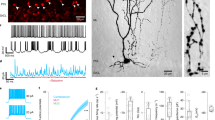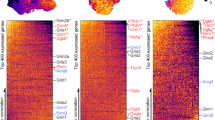Abstract
IN the cerebellum, NMDA (N-methyl-d-aspartate) receptors play an important role in neuronal differentiation1,2 and excitatory synaptic transmission3–5. During early cerebellar development, marked changes occur in the distribution of messenger RNAs encoding various NMDA-receptor subunits6. To determine whether these changes result in the appearance of functionally distinct NMDA receptors7–9, we have recorded single-channel currents in rat cerebellar granule cells during the period of their migration from the external germinal layer to the inner granular layer10. Here we show that before synapse formation10,11, pre-migratory and migrating granule cells express NMDA receptors possessing single-channel properties similar to those previously described for many central neurons12-16. In contrast, mature post-migratory cells also express an atypical form of NMDA receptor that has a lower single-channel conductance and distinct kinetic behaviour. The properties of these 'low-conductance' channels correspond to those described17 for recombinant NMDA receptors formed by co-expression of NR1 and NR2C subunits8,9. The NR2C subunit appears postnatally and is found predominantly in the adult cerebellum6–8. Our data demonstrate developmental changes in NMDA-receptor properties at the single-channel level, and suggest that in the cerebellum the expression of a specific subunit protein results in a distinct form of native receptor.
This is a preview of subscription content, access via your institution
Access options
Subscribe to this journal
Receive 51 print issues and online access
$199.00 per year
only $3.90 per issue
Buy this article
- Purchase on Springer Link
- Instant access to full article PDF
Prices may be subject to local taxes which are calculated during checkout
Similar content being viewed by others
References
Komuro, H. & Rakic, P. Science 260, 95–97 (1993).
Rabacchi, S., Bailly, Y., Delhaye-Bouchaud, N. & Mariani, J. Science 256, 1823–1825 (1992).
Garthwaite, J. & Brodbelt, A. R. Neuroscience 29, 401–412 (1989).
Silver, R. A., Traynelis, S. F. & Cull-Candy, S. G. Nature 355, 163–166 (1992).
D'Angelo, E., Rossi, P. & Taglietti, V. Neuroscience 53, 121–130 (1993).
Watanabe, M., Inoue, Y., Sakimura, K. & Mishina, M. Neuroreport 3, 1138–1140 (1992).
Kutsuwada, T. et al. Nature 358, 36–41 (1992).
Monyer, H. et al. Science 256, 1217–1221 (1992).
Ishii, T. et al. J. biol. Chem. 268, 2836–2843 (1993).
Altman, J. J. comp. Neurol. 145, 465–514 (1972).
Hamori, J. & Somogyi, J. J. comp. Neurol. 220, 365–377 (1983).
Nowak, L., Bregestovski, P., Ascher, P., Herbet, A. & Prochiantz, A. Nature 307, 462–465 (1984).
Cull-Candy, S. G. & Usowicz, M. M. Nature 325, 525–528 (1987).
Jahr, C. E. & Stevens, C. F. Nature 325, 522–525 (1987).
Howe, J. R., Cull-Candy, S. G. & Colquhoun, D. J. Physiol., Lond. 432, 143–202 (1991).
Gibb, A. J. & Colquhoun, D. J. Physiol., Lond. 456, 143–179 (1992).
Stern, P., Béhé, P., Schoepfer, R. & Colquhoun, D. Proc. R. Soc. Lond. B250, 271–277 (1992).
Hamill, O. P., Marty, A., Neher, E., Sakmann, B. & Sigworth, F. J. Pflügers Arch. 391, 85–100 (1981).
Mayer, M. L., Westbrook, G. L. & Guthrie, P. B. Nature 309, 261–263 (1984).
Garthwaite, G., Yamini, B. Jr & Garthwaite, J. Devl Brain Res. 36, 288–292 (1987).
Blanton, M. G. & Kriegstein, A. R. J. Neurophysiol. 67, 1185–1200 (1992).
Sah, P., Nicoll, R. A. & Hestrin, S. Science 246, 815–818 (1989).
Carmignoto, G. & Vicini, S. Science 258, 1007–1011 (1992).
Hestrin, S. Nature 357, 686–689 (1992).
Mishina, M. et al. Nature 321, 406–411 (1986).
Takahashi, T., Momiyama, A., Hirai, K., Hishinuma, F. & Akagi, H. Neuron 9, 1155–1161 (1992).
Johnson, J. W. & Ascher, P. Nature 325, 529–531 (1987).
Edwards, F. A., Konnerth, A., Sakmann, B. & Takahashi, T. Pflügers Arch. 414, 600–612 (1989).
Colquhoun, D. & Sigworth, F. J. in Single-Channel Recording (eds Sakmann, B. & Neher, E.) 191–263 (Plenum, London, 1983).
Sigworth, F. J. & Sine, S. M. Biophys. J. 52, 1047–1054 (1987).
Rossi, D. J. & Slater, N. T. Neuropharmacology 32, 1239–1248 (1993).
Author information
Authors and Affiliations
Rights and permissions
About this article
Cite this article
Farrant, M., Feldmeyer, D., Takahashi, T. et al. NMDA-receptor channel diversity in the developing cerebellum. Nature 368, 335–339 (1994). https://doi.org/10.1038/368335a0
Received:
Accepted:
Issue Date:
DOI: https://doi.org/10.1038/368335a0
This article is cited by
-
Progresses in GluN2A-containing NMDA Receptors and their Selective Regulators
Cellular and Molecular Neurobiology (2023)
-
Involvement of NMDA receptors containing the GluN2C subunit in the psychotomimetic and antidepressant-like effects of ketamine
Translational Psychiatry (2020)
-
Presynaptic NMDA receptors control nociceptive transmission at the spinal cord level in neuropathic pain
Cellular and Molecular Life Sciences (2019)
-
Neuroprotection Mediated through GluN2C-Containing N-methyl-D-aspartate (NMDA) Receptors Following Ischemia
Scientific Reports (2016)
-
Regulation of chromatin accessibility and Zic binding at enhancers in the developing cerebellum
Nature Neuroscience (2015)
Comments
By submitting a comment you agree to abide by our Terms and Community Guidelines. If you find something abusive or that does not comply with our terms or guidelines please flag it as inappropriate.



